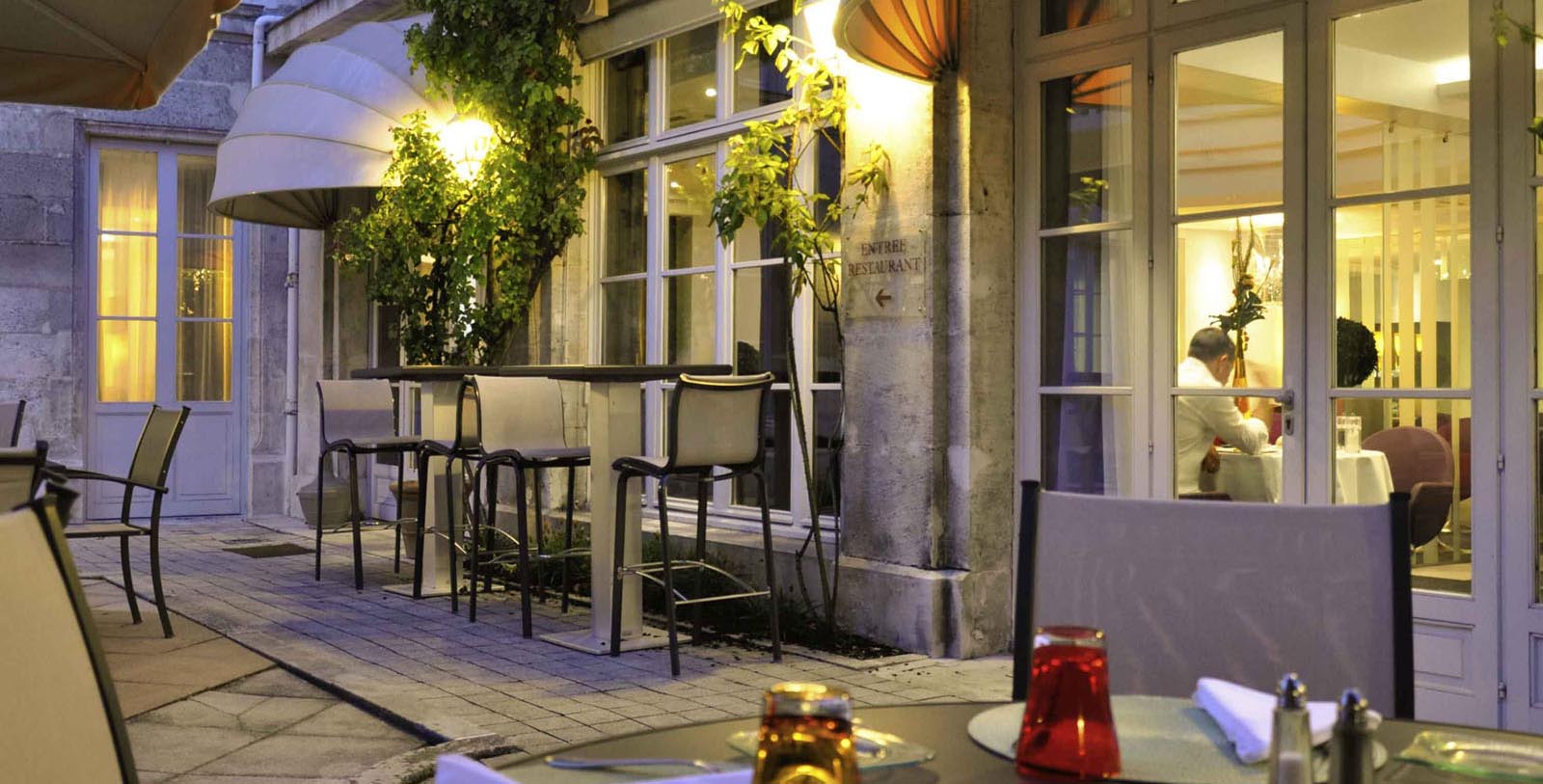Receive for Free - Discover & Explore eNewsletter monthly with advance notice of special offers, packages, and insider savings from 10% - 30% off Best Available Rates at selected hotels.
history
Discover the Mercure Angouleme Hotel de France, which once had deep connections to the Ancien Régime.
Mercure Angouleme Hotel de France, a member of Historic Hotels Worldwide since 2019, dates back to the late 1500s.
VIEW TIMELINEThe illustrious history of the Mercure Angoulême Hôtel de France dates back to the late 16th century, when Guillaume Guez—Mayor of Angoulême—constructed the building as a symbol of his wealth and success. Guillaume Guez and his wife, Marie Nesmond, also purchased a plot of land outside of town where he built the “Château de Balzac.” Shortly thereafter, he was ennobled as the “Guillaume Guez de Balzac.” On June 1, 1597, Guez and his wife welcomed a son into the world named Jean-Louis Guez de Balzac, whom they baptized in Saint Paul’s on rue des Arceaux. (The church no longer exists, but the stained-glass windows can be seen by looking at the arches on the street next to the hotel.) Jean-Louis Guez de Balzac would grow to be a prominent French writer and was known widely across France for his outstanding contributions to French literature. Today, Jean-Louis Guez de Balzac is chiefly known for his collection of letters, which were first published in 1624. Guez de Balzac is championed for the elegance and harmony of his writing, which had not previously been seen in French prose. Many consider his writings to demonstrate the true mastery of incorporating clarity and precision, ultimately encouraging the development of the modern French language. Guillaume Guez de Balzac went on to reach much acclaim in his life, so much so that a school was named after him in downtown Angoulême called the “Lycée Guez de Balzac of Angoulême.”
During the reign of the great Louis XIV, Angoulême prepared to receive the King of France, who was eleven years old at the time. He spent four days in Angoulême, staying at the Guez residence downtown with Lord Mazarin (who governed the kingdom at the time) and Anne of Austria, his mother. Throughout his stay, Louis XIV—the Sun King—hosted all of Angoulême’s most important people. The Guez residence was then bequeathed by a nephew of the family to the Carmelites of Angoulême to use as a convent. The sisters never had the means to restore it, so the building was rented out for generations. A man named “Astier” came to own the building in 1810, who demolished it in favor of a beautiful boutique hotel that sat upon the structure’s foundation. Astier spared no expense, either, spending lavishly to ensure the new building closely resembled the original. Nevertheless, in 1875, the building then rebranded as the “Hôtel de France” to great acclaim. It remained the Hôtel de France for many years thereafter, even as the German army occupied the structure throughout most of World War II. A century later, AccorHotels acquired the magnificent Mercure hotel brand, thus, obtaining all of the latter’s members as a result. Hôtel de France would eventually become a part of AccorHotels years later, joining its esteemed Mercure collection in the process. Inducted into Historic Hotels Worldwide in 2019, this magnificent historic hotel has since existed as the prestigious “Mercure Angoulême Hôtel de France.”
-
About the Location +
Overlooking a meander of the Charante, Angoulême is an ancient community steeped in history. While historians today often have great difficulty pinpointing an exact date for when the settlement first appeared, archeological evidence does confirm that it existed during Roman times. Most scholars have subsequently concluded that it was a small town, with no major roads linking the community to the larger province of Aquitania until the eve of Rome’s collapse. The community barely had any significant municipal structures of note, too, and no prolific public monuments. But its heightened elevation above the Charante gradually made it an attractive place to house a military garrison, inspiring Roman engineers to construct a 66-acre ring fortress around the town. When Rome finally did fall in the 5th century AD, the Visigoths incorporated the settlement into a kingdom they formed out of Aquitania (sometimes called the Kingdom of the Visigoths). The Frankish king Pepin the Short then conquered the town—and the rest of Aquitania—during the 8th century, reorganizing most of the Visigothic kingdom as the “Duchy of Aquitaine.” The town itself served as the capital of the new the “County of Angoulême,” becoming known simply as “Angoulême.” Also known popularly as “Angoumois,” the County of Angoulême” was a fiefdom within duchy that the powerful Lusignan family ruled for generations. As such, the Lusignans used the City of Angoulême as their base of power.
By the 12th century, the County of Angoulême and the Duchy of Aquitaine were both sworn directly to the King of England, despite being located in France. Before inheriting the English throne in 1154, King Henry II held hereditary titles to the counties of Anjou and Maine, as well as the dukedom of Normandy. Furthermore, his marriage to Eleanor of Aquitaine gave him control over most of western France, creating a massive realm that historians now call the “Angevin Empire.” Even though Henry was the suzerain of England at the time, he was still a vassal to the French monarchy. As such, both sides became embroiled in a bitter rivalry that saw Henry’s descendants lose much of their continental possessions at the start of the next century. The final king to lose control over most of the land was King John I, who had actually married a member of the Lusignan family, Isabella of Angoulême. The Lusignan line of counts was eventually extinguished in the male line in 1302, prompting the French king to seize the County of Angoulême as a royal possession. Henry II’s distant descendants nonetheless yearned to obtain their landholdings in western France, and fought numerous wars throughout the 14th century to reconquer County of Angoulême and the Duchy of Aquitaine. (All of the battles were part of the famed Hundred Years’ War.) When the English were finally defeated in 1373, King Charles V of France granted the county and its capital town to his uncle, Duke Louis d’Orléans.
Angoulême and the rest of the County of Angoulême continued to hold close connections to the Ancien Régime, with King Francis I of France even serving as the local count before his ascension to the throne in 1515. Francis I became well-known internationally for the impressive construction projects he completed throughout his reign, including Château de Chambord, Château du Louvre, and Château de Fontainebleau. He adored Angoulême and spoke fondly of the city saying, "Angouleme, un doux air bénin,” meaning, “that to live there is to breathe well.” Francis I’s sister, Marguerite de Valoi, was born in Angoulême in the round tower of the current town hall. Marguerite was an exceptional woman of her time, as she was very educated and became one of the first female writers in all of France. But Angoulême’s ties to the French monarchy came to an end during the French Revolution, when republican revolutionaries executed King Louis XVI in 1789. (King Louis XVI was a descendant of the Bourbons, another cadet branch of the Capet dynasty founded nearly a millennia prior. The Bourbons briefly returned to power intermittently throughout the early 19th century before being ousted a final time amid the July Revolution of 1830.) Angoulême thrived even without its royal patrons, though, as many new industries—most notably the manufacture of paper—became ubiquitous throughout the town. Today, Angoulême is one of the best places to visit in western France. It is home to many fantastic cultural attractions, including the likes of the Hôtel De Ville Angoulême, Angoulême Cathedral, the Musée D’Angoulême, and the Musée du Papier.
-
About the Architecture +
When this brilliant historic structure underwent its transformation into the “Hôtel de France” in the late 19th century, its ownership group decided to use the architectural characteristics of the Belle Époque as the source of their inspiration. The architectural style of the Belle Époque was quite ubiquitous across France—specifically Paris—at the height of the Victorian Era. The name “Belle Époque” specifically referred to time in European history marked by its technological advances, pristine artwork, and relative peace. While the Belle Époque is a historical period relevant to most Western countries, it specifically applies to France and the life of the French Third Republic (1870 – 1914). Its emphasis on modernity seemed to better represent Western culture as it emerged from the aftermath of World War I. Belle Époque architectural actually drew its inspiration from a range of earlier forms that included Moorish Revival and Renaissance Revival-style architecture. More recent architectural styles also constituted aspects of Belle Époque architecture, such as the palatial designs of 17th and 18th century French châteaus.
Perhaps the most famous style to emerge within the greater umbrella of Belle Époque architecture was that of Art Nouveau. Defined by its ornate interior designs, Art Nouveau was best represented by Hector Guimard’s wonderful “Castel Béranger” in 1898. Architects who embraced the Art Nouveau were among a growing demographic of intellectuals that yearned to create novel artistic forms that broke with the imitative historicism of the past. More importantly, they wanted their new architectural motifs to reflect imaginative creativity, especially as European society became increasingly more structured and industrialized. Over time, those professionals created a design aesthetic characterized by its curvaceous lines and use of organic shapes. Objects from nature were featured prominently throughout the façade of every structure, too, including the likes of insects and exotic plants. Surfaces often contained terra cotta coverings, and ornate tile moldings spread throughout the interior. But despite its immense popularity, Belle Époque architecture was eventually phased out during the 1920s in favor of a newer style known as “Art Deco” that seemed to better reflect Western perceptions about modernity.
-
Famous Historic Events +
Assassination of King Henry IV of France (1610): In 1610, a local nobleman named François Ravaillac assassinated King Henry IV in downtown Angoulême. His family’s house was subsequently demolished, with the land transformed into a beautiful garden. In the aftermath of the assassination, Marie de’ Medici—the widow of Henry IV—ruled in the name of their son, Louis XIII, who was still too young to assume the throne. She became head of the regency council until 1617, when her son finally matured in age. But a political crisis quickly broke out when the new king finally became old enough to rule on his own. Worried about her place in the French court, the queen mother insisted that she remain in power over the king’s affairs. Incensed, King Louis XIII had his mother imprisoned in the Château de Blois. Fortunately for Marie de’ Medici, the Duke of Epernon and several supporters ferried the queen mother to Angoulême, where she stayed with Guillaume Guez for some time. Despite her exile, the queen mother raised a massive army that was bent on overthrowing the king. For a brief time, though, both mother and son managed to briefly reconciled in 1619 via the Treaty of Angoulême. Per the treaty, King Louis XIII was given the cities of Angers and Chinon, but was forbidden to return to the council. Nevertheless, the peace proved to be short-lived, as Marie de’ Medici ultimately fomented a civil war a year later. Even though her army was a formidable force, King Louis XIII shattered it as the Battle of Ponts-de-Cé. Out of fear that his mother was still plotting against him, King Louis XIII reconciled a final time with Marie de’ Medici. But due to the dowager queen’s incessant intrigue within the French court in the years afterward, King Louis XIII his mother to the Holy Roman Empire in the 1630s.
-
Famous Historic Guests +
King Louis XIV of France (1643 – 1715)
Anne of Austria


























